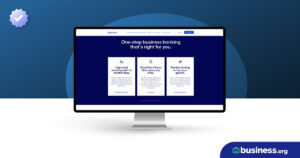💸 See if your business qualifies for a tax credit worth up to $26k per employee. 📞 Call Now: 855-979-9597
How to File Taxes If You’re Self-Employed
We are committed to sharing unbiased reviews. Some of the links on our site are from our partners who compensate us. Read our editorial guidelines and advertising disclosure.
If you earned more than $400 working for yourself last year, the IRS considers you a self-employed individual. This means that along with filing an annual return, you’ll need to pay income taxes and self-employment taxes—and yes, those are two different types of taxes. Plus, if you anticipate owing at least $1,000 on your annual tax return, you’re required to file all your taxes quarterly. (If you’re a freelancer, independent contractor, or sole proprietor, this means you.)
On this page, we explain what the self-employment tax is and how to file it. If you want more information on filing all types of taxes while you’re self-employed, check out our piece on how to file small-business taxes. Or, if you’re a freelancer, see our article on paying taxes as an independent contractor instead.
How to file self-employment taxes
By signing up I agree to the Terms of Use and Privacy Policy.
1. Understand the self-employment tax
Traditional employees pay half of their own Medicare and Social Security taxes, with their employer matching the second half. However, if you’re self-employed, you’re both employer and employee. Along with withholding and filing your own income tax, you’ll also pay both the employee and employer halves of the FICA tax. That’s a 12.4% tax for Social Security and a 2.9% tax for Medicare, or 15.3% total.
While the Social Security tax applies only to the first $137,700 of your income, the Medicare tax applies to your entire income.
As a self-employed individual, you can claim the employer portion of your self-employment tax as a deduction. Read the IRS’s guide for a complete list of deductions.
2. Determine if you should pay taxes quarterly or annually
Quarterly payments
If you expect to owe $1,000 or more in income and self-employment taxes when you file your annual return, you must make quarterly estimated tax payments. Generally speaking, that means full-time freelancers, independent contractors, and some small-business owners should file income taxes and self-employment taxes quarterly.
To file quarterly, you’ll need to estimate your gross annual income, then pay your income tax and self-employment taxes based on that estimate. Your estimate needs to be as accurate as possible—otherwise, you could end up owing a heap of taxes on April 18, plus fines for underpaying.
If you want to calculate your quarterly tax payment by hand, use Form 1040-ES, the IRS’s worksheet for tax estimation. In the true spirit of tax forms, the instructions and worksheet are thorough, but confusing. To make sure you’re paying correctly, we recommend talking to an accountant or financial advisor before paying your quarterly taxes for the first time.
Alternatively, you can use accounting software like QuickBooks Online, which includes built-in quarterly tax estimation.
Annual payments
On the other hand, if you don’t expect to owe more than $1,000 when you file your annual return, you aren’t required to make quarterly tax payments. But before you decide to pay either quarterly or annually, consult with an accountant or tax professional.
If you try to pay a lump sum instead of making quarterly payments, you’ll be charged interest, fines, and other fees. For the sake of your bottom line, you need to establish the right tax-filing schedule right away: speaking with an accountant is the best way to do so.

- Outsource your bookkeeping. Merritt Bookkeeping's affordable outsourced bookkeeping saves business owners time and money.
- Opt for all-in-one business checking. Found is the perfect match for teams of one looking for smart tax tools.
- Get better accounting software. Quickbooks is our top pick for businesses looking for comprehensive features that simplify tax season.
Annual filing
Whether you pay taxes quarterly or annually, you’ll file an annual tax return. For this process, you submit your quarterly payment and various IRS forms that show exactly how much you earned. (Our piece on small-business taxes, including self-employment taxes, explains that paperwork in detail.)
For most individuals and businesses, annual tax-filing paperwork is usually due April 15 each year (though some business types need to file by March 15). If you don’t have your paperwork together in time, you can apply for a tax-filing extension. Just remember that while an extension pushes your paperwork deadline back six months, it doesn’t delay your actual tax payment. To avoid late fees and other penalties, you need to pay by the original deadline.
3. Pay your income and self-employment taxes on time
Once you’ve determined whether you need to pay quarterly or annually and used Form 1040-ES to calculate your income and self-employment taxes, it’s time to pay.
If you’re paying quarterly, your taxes are due on the following dates:
- January 15, 2023
- April 18, 2023
- June 15, 2023
- September 15, 2023
If you’re paying annually, your filing deadline depends on the type of business you own:
- Partnerships, S corporations, and multi-member LLCs must file by March 15, 2023.
- Anyone who files taxes as an individual—which usually includes sole proprietors and single-member LLCs—must file by April 18, 2023.
If you’re still not sure when your taxes are due, we recommend consulting with an accountant who can give tax-filing advice specific to your business. Plus, if you use accounting or bookkeeping software (including free accounting software like Wave), you can easily access all the financial data you need to file taxes on time and accurately.
You have a few options for sending your taxes to the IRS. The most straightforward option is to use the IRS’s online payment system. (You can also mail a check, but paying online is simpler and faster.) An accountant or tax professional can file for you. Alternatively, you can use small-business tax software to file your self-employment and income taxes.

Get your maximum refund for your small business with FreeTaxUSA.
The takeaway
There’s no way around it: calculating and paying quarterly self-employment taxes is tedious. But you can speed up the three-step process by consulting with a tax professional the first time you pay self-employment taxes, filing on time, and staying on top of quarterly payments.
Make sure you know all the 2023 tax dates for the 2022 fiscal year—read through our piece on this year’s filing deadlines.
Related content
Disclaimer
At Business.org, our research is meant to offer general product and service recommendations. We don't guarantee that our suggestions will work best for each individual or business, so consider your unique needs when choosing products and services.




